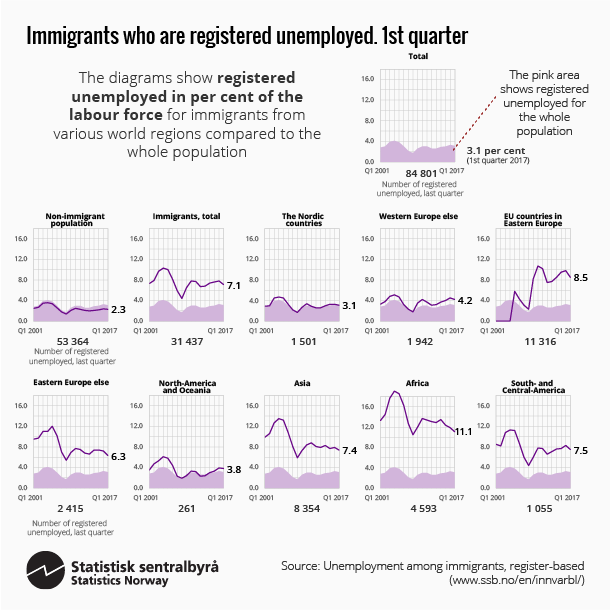Continued decline among immigrants
Published:
Registered unemployment among immigrants decreased from 7.8 per cent in February 2016 to 7.1 per cent in February 2017, while the unemployment rate decreased from 2.4 to 2.3 per cent within the rest of the population.
- Full set of figures
- Registered unemployed among immigrants (discontinued in Statistics Norway)
- Series archive
- Registered unemployed among immigrants (archive)
Almost 31 500 immigrants were registered as unemployed at the end of February 2017, which is the reference time of the 1st quarter. This constitutes 37 per cent of the registered unemployed in total.
- See more figures in the statistics Unemployment among immigrants, register-based
Increase among participants on labour market schemes
On the contrary, the number of immigrants who participated in labour market schemes went up by 1 800 from February 2016 to February 2017, which constituted a growth of 24.7 per cent within this participant group. In total, 40 820 immigrants were registered as unemployed or participants of labour market schemes (i.e. the gross unemployment) in the 1st quarter of 2017. This constitutes a gross unemployment rate of 9.3 per cent among immigrants (as a percentage of the labour force). This rate went down by 0.3 percentage points from 2016 to 2017. The gross unemployment rate within the rest of the population was 2.8 per cent in February 2017, which was 0.1 percentage point lower compared to 2016.
African immigrants still have the highest unemployment rate
There was a decline in the unemployment rate within all of the immigrant groups, but with some variations. Immigrants from the EU countries in Eastern Europe had the strongest fall, 1.3 percentage points, while those from the same region outside the EU had a decline of 0.9 percentage points. The immigrants from Africa and Latin America also had a decrease, 0.8 percentage points within both groups. The remaining groups had declines between 0.1 and 0.5 percentage points.
African immigrants still have the highest unemployment rate, at 11.1 per cent in the 1st quarter, which is due to the large percentage of refugees within this group. Next were immigrants from the EU countries in Eastern Europe at 8.5 per cent. The immigrants from Asia and Latin America had 7.5 and 7.4 per cent respectively, while those from Eastern Europe outside the EU had 6.3 per cent registered unemployed. As usual, the remaining groups had rates far below the immigrant average: Western Europe (4.2 per cent), North America and Oceania (3.8 per cent) and the Nordic countries (3.1 per cent).
Higher unemployment rate among male immigrants
Male immigrants have a slightly higher unemployment rate than female immigrants, 7.4 per cent versus 6.8 per cent in the 1st quarter. The same pattern is observed within the rest of the population, with 2.8 per cent among men and 1.7 per cent among women.
Figure 2. Immigrants who are registered unemployed, by county of residence. In per cent of the labour force
| Per cent | |
| Finnmark Finnmárku | 7.3 |
| Troms Romsa | 4.2 |
| Nordland | 6.3 |
| Nord-Trøndelag | 7.2 |
| Sør-Trøndelag | 6.6 |
| Møre og Romsdal | 8.0 |
| Sogn og Fjordane | 5.0 |
| Hordaland | 8.3 |
| Rogaland | 10.2 |
| Vest-Agder | 8.7 |
| Aust-Agder | 8.7 |
| Telemark | 9.0 |
| Vestfold | 8.5 |
| Buskerud | 6.7 |
| Oppland | 6.2 |
| Hedmark | 6.5 |
| Oslo | 6.2 |
| Akershus | 5.2 |
| Østfold | 8.9 |
| The whole country | 7.1 |
Lower unemployment among Norwegian-born to immigrant parents than immigrants
Norwegian-born to immigrant parents is still a rather small group of unemployed persons. This group constituted 1 174 registered unemployed persons in the 1st quarter of 2017. A large share of this group is aged 15-29 years, and the unemployment rate within this age group was 4.1 per cent. Immigrants and the rest of the population at the same age had 8.2 and 3.2 per cent unemployed respectively.
Both Norwegian-born to immigrant parents and the rest of the population aged 15-29 years had a decrease of 0.7 percentage points, while there was a decline of 1 percentage point among immigrants.
Contact
-
Bjørn Olsen
-
Ingebjørg Aamodt
-
Statistics Norway's Information Centre

